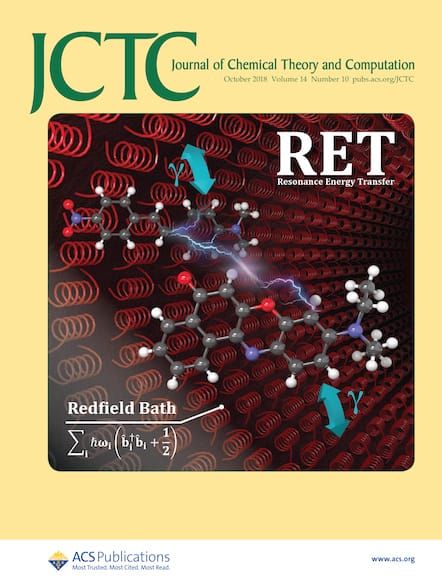Efficient Subsystem TDDFT Calculations for Optical Rotatory Dispersion of Molecules in Solution: Converging the Configurational Averaging for Norbornenone in Acetonitrile.
IF 5.5
1区 化学
Q2 CHEMISTRY, PHYSICAL
引用次数: 0
Abstract
We present a comprehensive study on optical rotatory dispersion (ORD) calculations for a chiral molecule in solution by means of subsystem TDDFT (sTDDFT) for snapshots extracted from classical molecular dynamics (MD) trajectories. As a prototypical example, we study the ORD of norbornenone in acetonitrile. Uncovering the microscopic origin of the solvent effect on the ORD necessitates an explicit quantum chemical solvation model and robust configurational sampling, rendering such calculations computationally extremely heavy. Here, we employ sTDDFT to study the convergence of the ORD signal with respect to both the size of the solvation shell considered and the number of snapshots considered in the configurational sampling, as well as the interdependence of these two factors. We demonstrate that several thousand snapshots have to be considered to accurately converge the solvation effect even for comparatively small solvated clusters. By systematically studying solvent cages of increasing size, we observe a clear correlation between the radial distribution function of acetonitrile around norbornenone and the ORD dependence on the solvent-shell size. Larger solvation shells, unfortunately, usually also require more extensive configurational sampling. To facilitate such an averaging procedure on a quantum chemical basis, we introduce further algorithmic improvements to achieve an additional speed up in our sTDDFT calculations. We observe that sTDDFT accurately captures the qualitative features of the solvation-shell size dependence. In addition, a systematic empirical correction is developed to achieve quantitative agreement with the parent TDDFT results. Overall, sTDDFT in combination with classical MD for snapshot generation offers an economical approach toward obtaining converged ORD results in solution.溶液中分子旋光色散的高效子系统TDDFT计算:降冰片烯酮在乙腈中的构型平均收敛。
本文利用从经典分子动力学(MD)轨迹中提取的快照的子系统TDDFT (sTDDFT),对溶液中手性分子的旋光色散(ORD)计算进行了全面的研究。以降冰片烯酮为例,研究了其在乙腈中的反应。要揭示溶剂效应对ORD的微观起源,需要一个明确的量子化学溶剂化模型和健壮的构型采样,这使得计算非常繁重。在这里,我们使用sTDDFT来研究ORD信号在考虑溶剂化壳的大小和配置采样中考虑的快照数量方面的收敛性,以及这两个因素的相互依赖性。我们证明了几千个快照必须考虑精确收敛的溶剂化效应,即使是相对较小的溶剂化簇。通过对溶剂笼尺寸增大的系统研究,我们观察到乙腈在降冰片烯酮周围的径向分布函数与ORD对溶剂壳尺寸的依赖之间存在明显的相关性。不幸的是,较大的溶剂化层通常也需要更广泛的配置采样。为了在量子化学的基础上促进这种平均过程,我们引入了进一步的算法改进,以实现sTDDFT计算的额外速度。我们观察到sTDDFT准确地捕获了溶剂壳尺寸依赖关系的定性特征。此外,开发了一个系统的经验修正,以实现与母体TDDFT结果的定量一致。总的来说,sTDDFT与经典MD相结合用于快照生成,为在解决方案中获得收敛ORD结果提供了一种经济的方法。
本文章由计算机程序翻译,如有差异,请以英文原文为准。
求助全文
约1分钟内获得全文
求助全文
来源期刊

Journal of Chemical Theory and Computation
化学-物理:原子、分子和化学物理
CiteScore
9.90
自引率
16.40%
发文量
568
审稿时长
1 months
期刊介绍:
The Journal of Chemical Theory and Computation invites new and original contributions with the understanding that, if accepted, they will not be published elsewhere. Papers reporting new theories, methodology, and/or important applications in quantum electronic structure, molecular dynamics, and statistical mechanics are appropriate for submission to this Journal. Specific topics include advances in or applications of ab initio quantum mechanics, density functional theory, design and properties of new materials, surface science, Monte Carlo simulations, solvation models, QM/MM calculations, biomolecular structure prediction, and molecular dynamics in the broadest sense including gas-phase dynamics, ab initio dynamics, biomolecular dynamics, and protein folding. The Journal does not consider papers that are straightforward applications of known methods including DFT and molecular dynamics. The Journal favors submissions that include advances in theory or methodology with applications to compelling problems.
 求助内容:
求助内容: 应助结果提醒方式:
应助结果提醒方式:


